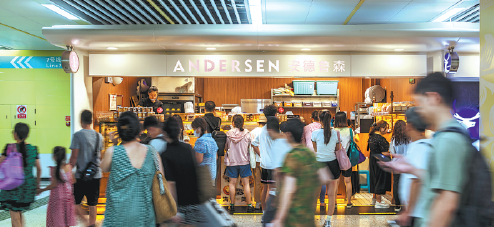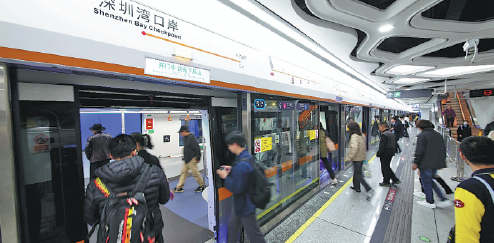MTR expects sustainable rail transit as a new economic growth driver

The China Development Forum 2025, themed "Unleashing Development Momentum for Stable Growth of Global Economy", is being held in Beijing from Sunday to Monday. MTR Corporation is participating in this event for the 19th consecutive year.
Jacob Kam, CEO of the Hong Kong-based railway operator, expressed gratitude for the direct dialogue with central government officials facilitated by the platform.
He highlighted the central government's support for both foreign and Hong Kong enterprises operating on the Chinese mainland, which reinforces China's commitment to openness and its dedication to fostering global development.
Urban development
The year 2025 marks the closing of the 14th Five-Year Plan (2021-25), which has boosted high-quality development to lay a foundation for the 15th Five-Year Plan (2026-30). Urban rail transit has accelerated the flow of people, optimized urban structures and propelled high-quality economic growth, becoming "arteries" that help economic circulation and stimulate consumption.
Hong Kong's public transportation system is globally renowned for its service quality. Over the past few decades, the city has implemented a model of rail transit-driven urban development. The extensive MTR network has not only enhanced urban productivity but also aided the development of new communities and fostered unique shopping experiences around subway stations for more than 8 million passengers daily, according to the company.
Today, nearly 90 percent of total passenger journeys in Hong Kong are made on the public transport system, with MTR's network accounting for more than half of the franchised public transport market.
Enhanced connectivity
In recent years, as Hong Kong has been accelerating its integration into overall national development, the interactions and economic relations between Hong Kong and the Chinese mainland have grown closer, particularly in the integrated development of the Guangdong-Hong Kong-Macao Greater Bay Area, where efficient railway services play a crucial role.
In 2024, the cross-boundary high-speed rail connecting Hong Kong and the mainland witnessed a surge in passengers, exceeding 26 million trips for the entire year. The number of direct destinations has more than doubled in the past two years. The introduction of the overnight sleeper train service to Beijing and Shanghai in 2024 not only reduced travel times but also drove economic growth and enhanced connectivity.
Additionally, the initial section of Shenzhen Metro Line 13 Phase I, which MTR Corporation invested in, constructed and operates through a public-private partnership model, commenced passenger service in December 2024.
The new railway line connecting to the Shenzhen Bay checkpoint has further assisted the movement of people between Hong Kong and Shenzhen, as well as the wider Greater Bay Area. This marks another milestone in the GBA's connectivity, boosting the flow of talent, capital and innovation resources.
Major investment
Over the past two decades, MTR has participated in the development of the Chinese mainland's rail transit system, operating more than 300 kilometers of rail transit lines in Beijing, Hangzhou and Shenzhen, with a total investment of over 60 billion yuan ($8.27 billion).
Sharing the "rail plus community" approach and transit-oriented development experience, MTR has invested in transit-oriented development projects in Beijing, Hangzhou and the GBA.
By the end of 2024, the total operating length of 325 urban rail transit lines across 54 Chinese mainland cities reached 10,945.6 km. This network, with 6,324 stations, is continuing to expand.
The construction and operation of railway projects, as well as long-term maintenance and asset renewal, involve substantial resources. In addition to the "rail plus community" development model, MTR also explores innovative ways to diversify income streams, such as leveraging the massive passenger traffic to drive up consumer spending and promote the growth of domestic consumption.
Station commerce
MTR's latest financial report shows that its Hong Kong railway network saw station commercial business contribute profits of HK$3.77 billion ($485 million) in 2024.
Station commercial business not only enhances the financial sustainability of rail transit operations but also provides passengers with better travel experiences and richer consumption scenarios.
Kam said that in 2024, in response to the central government's initiative to develop "new domestic consumption models", MTR started to explore models for metro station commercial business in cities such as Chengdu, Zhengzhou and Xi'an. This initiative aims to make the best use of resources and infrastructure to assimilate, from a nationwide perspective, a "new domestic consumption model" into the sustainable development of metro systems.
Future commitments
Looking ahead, MTR is committed to supporting the Hong Kong Special Administrative Region government in building a future with railways as the city's transport backbone. Kam said: "As we start the new railway development cycle, we will continue to leverage our expertise in harnessing the opportunities and tackling the challenges ahead.
"MTR is committed to advancing multiple railway projects in Hong Kong to grow and connect communities, as well as to enhance the city's connection and integration with cities in the GBA. We will continue to drive the sustainable development of Hong Kong and keep cities moving."
Kam noted that MTR stands ready to seize the development opportunities outlined and supported by the central government, and will deepen collaborations with municipal governments in key areas such as metro construction and operations, transit-oriented development, and innovative commercial models.
"To add value to the high-quality and sustainable development of the metro sector on the Chinese mainland, we will collaborate with industry partners to enhance the ecosystem and inject new momentum into the economy," he added.





















